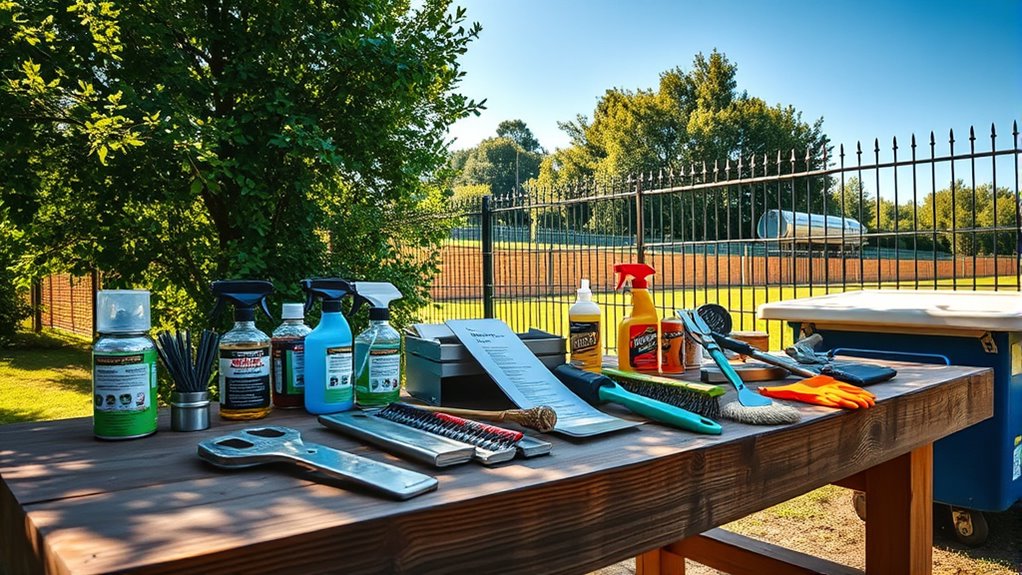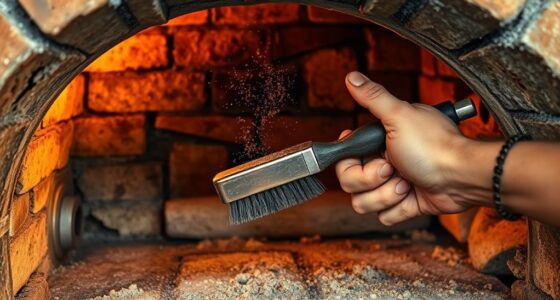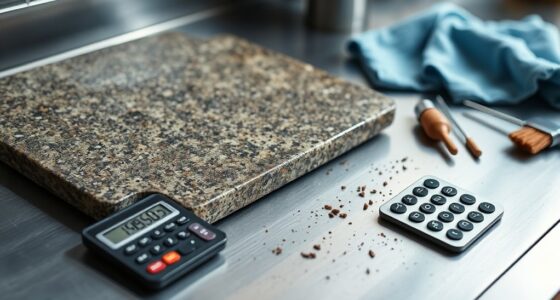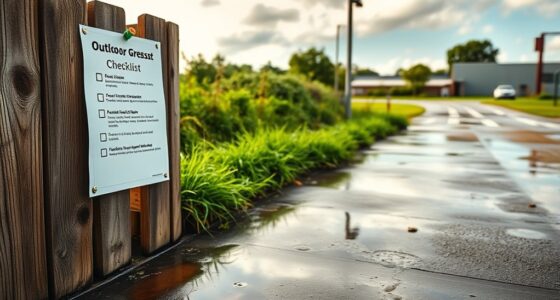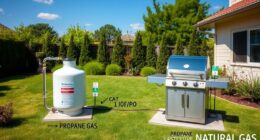Before starting outdoor rust prevention, assess your equipment’s condition and environment. Check for existing rust, material type, and exposure to elements like humidity or salt. Gather the right tools and protective gear, such as gloves, brushes, and spray bottles. Apply quality rust-proof coatings in thin layers on clean, dry surfaces, and consider waterproofing techniques. Maintain consistent cleaning and proper storage to extend your equipment’s lifespan—continue for more tips to stay ahead of rust problems.
Key Takeaways
- Assess outdoor environmental conditions and identify corrosion-prone areas before treatment.
- Gather proper protective gear and tools, including rust-proof sprays and cleaning supplies.
- Clean and dry surfaces thoroughly to ensure optimal adhesion of protective coatings.
- Apply high-quality, corrosion-inhibiting paints in multiple thin coats for effective protection.
- Store equipment in dry, covered areas and perform regular inspections to maintain rust prevention.
Assess Your Equipment and Environment

Before applying any rust prevention measures, you need to evaluate your equipment and environment. Start with a thorough corrosion analysis to identify existing rust or corrosion spots. This helps determine whether rust removal is necessary before protective steps. Check the material and age of your equipment—older or metal prone to rust requires more attention. Examine environmental factors like humidity, rainfall, and exposure to salt or pollutants, which accelerate corrosion. If your tools or machinery are stored outdoors, assess their current condition to prioritize cleaning and treatment. Understanding these factors ensures you choose appropriate rust removal methods and preventive measures. Additionally, paying attention to factors affecting corrosion can help you better anticipate potential issues. This initial evaluation sets the foundation for effective rust prevention, helping you extend your equipment’s lifespan and maintain its functionality.
Prepare Your Tools and Protective Gear

To guarantee effective rust prevention, you need to gather and prepare the right tools and protective gear. Start by selecting sturdy protective gloves to shield your hands from chemicals like rust proof spray and potential sharp edges. Make certain your spray bottle is clean and filled with a high-quality rust proof spray suitable for outdoor use. Keep a cloth or brush nearby to remove loose dirt and rust particles before applying treatments. Having these tools ready helps streamline the process and prevents accidental exposure to harmful substances. Double-check that your gloves fit properly and are in good condition to avoid tears. Proper preparation of your tools and protective gear ensures you work efficiently and stay safe while preventing rust on your equipment outdoors. Additionally, ensure your air purifier is well-maintained to improve indoor air quality during your project.
Apply Rust-Resistant Coatings and Treatments

Applying rust-resistant coatings and treatments is essential to protect your outdoor equipment from moisture and corrosion. Using high-quality protective paints infused with corrosion inhibitors creates a strong barrier against environmental damage. Before applying, guarantee surfaces are clean and dry for peak adhesion. Consider these key steps:
Protect outdoor equipment with rust-resistant coatings and regular maintenance for lasting durability.
- Choose coatings with effective corrosion inhibitors tailored for your equipment.
- Apply a primer if recommended, to enhance durability.
- Use multiple thin coats for even coverage, allowing proper drying time.
- Pay special attention to joints and edges where rust tends to form.
- Regularly inspect and touch up protective layers as needed.
- Incorporate waterproofing techniques to further safeguard exposed surfaces against moisture.
Establish Ongoing Maintenance and Storage Practices

Establishing ongoing maintenance and proper storage practices is crucial for keeping outdoor equipment rust-free over time. Regular cleaning removes dirt and moisture that accelerate rust, while inspections help catch early signs of corrosion. When storing tools or machinery outdoors, choose a dry, covered area to prevent exposure to moisture. Consider using protective covers or storing items in a shed or garage. Proper outdoor storage greatly enhances rust prevention by reducing environmental stressors. Additionally, understanding the family dynamics involved can inform better care and maintenance routines for your outdoor equipment.
Frequently Asked Questions
What Are the Best Weather Conditions for Rust Prevention Application?
You should apply rust resistant paint when the weather is dry, mild, and not too humid or rainy. Ideal conditions include low humidity and temperatures between 50-85°F, ensuring proper adhesion and curing. Avoid outdoor storage during application to prevent moisture exposure. Clear, dry days allow the paint to set fully, providing the best rust prevention. Always check the weather forecast to choose the perfect time for outdoor rust prevention efforts.
How Often Should Rust Prevention Treatments Be Reapplied Outdoors?
You should reapply a rust inhibitor every 6 to 12 months, depending on exposure and environmental conditions. Regular maintenance schedule guarantees your outdoor items stay protected. If you notice signs of rust or increased moisture, reapply sooner. Consistent treatments help prevent rust buildup and extend the lifespan of your equipment. Keep an eye on weather patterns and environmental factors to determine the best timing for reapplication, maintaining ideal rust protection.
Can Natural Remedies Effectively Prevent Rust Outdoors?
Natural remedies can help prevent rust outdoors, but they aren’t always as effective as DIY solutions designed for rust prevention. For example, applying lemon juice or vinegar can help, but environmental factors like humidity and rain may diminish their effectiveness over time. It’s best to combine natural remedies with regular maintenance and protective coatings to make certain your metal stays rust-free longer, especially when exposed to harsh outdoor conditions.
What Are Common Signs Indicating Rust Has Started on Equipment?
You’ll notice rust has started when you see rust spotting on your equipment’s surface or corrosion indicators like discoloration or flaking paint. These signs suggest moisture has caused oxidation, and rust is beginning to form. Keep an eye out for rough patches or pitted areas, which also indicate corrosion. Addressing these early signs promptly helps prevent further damage and prolongs the lifespan of your outdoor tools and equipment.
How Do I Choose the Right Rust-Resistant Coating for My Environment?
You should choose a rust-resistant coating based on your environment’s conditions. Look for metal primers that are suitable for exposure to moisture, salt, or chemicals, ensuring they enhance coating durability. Consider the level of protection needed; for example, marine environments require specialized coatings. Choose products with proven durability and compatibility with your equipment’s material. Testing a small area first can help confirm the coating’s effectiveness before full application.
Conclusion
By following this outdoor rust prevention checklist, you’ll protect your equipment and enjoy its longevity. It’s easy to overlook maintenance, but taking these steps now can save you money and frustration later. Don’t let rust ruin your tools or outdoor investments—act now and stay ahead of the damage. With consistent care, you can keep everything in top shape and avoid the disappointment of premature deterioration. Your future self will thank you for this simple, effective effort.
